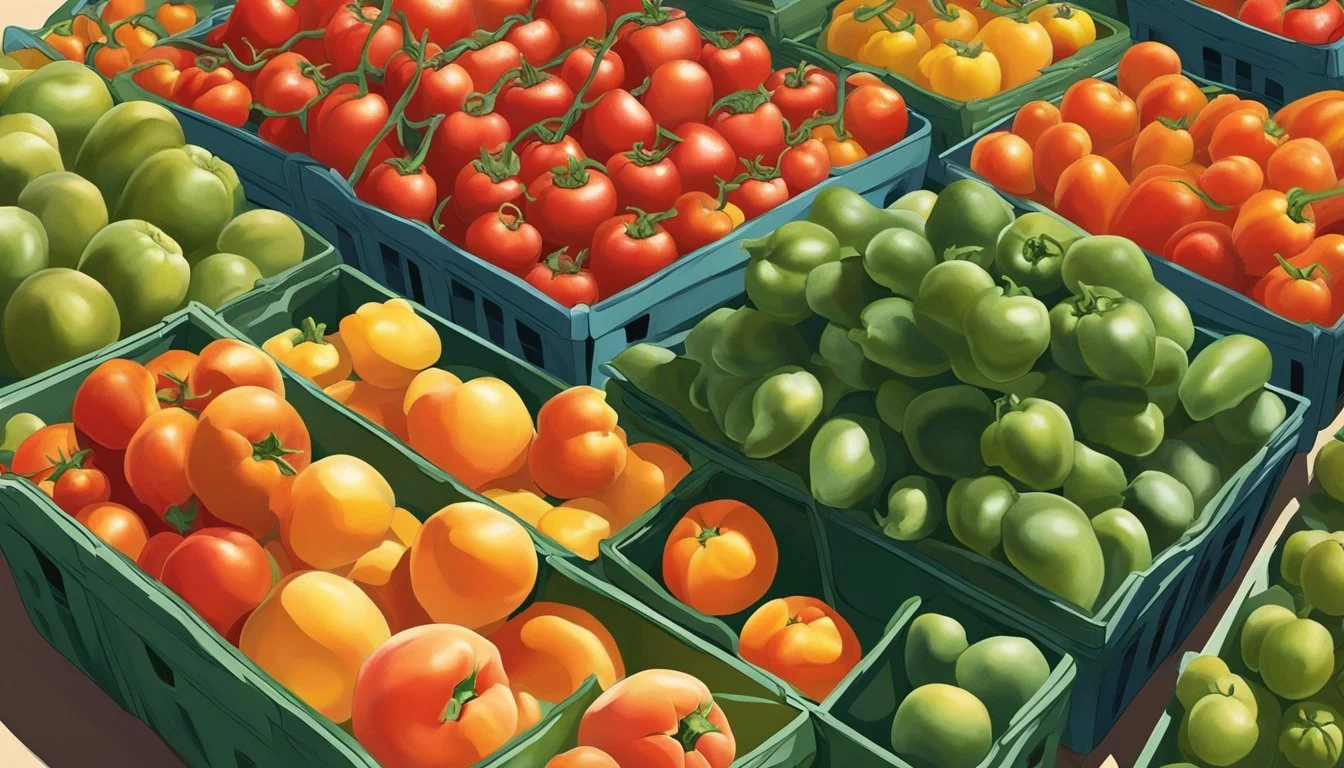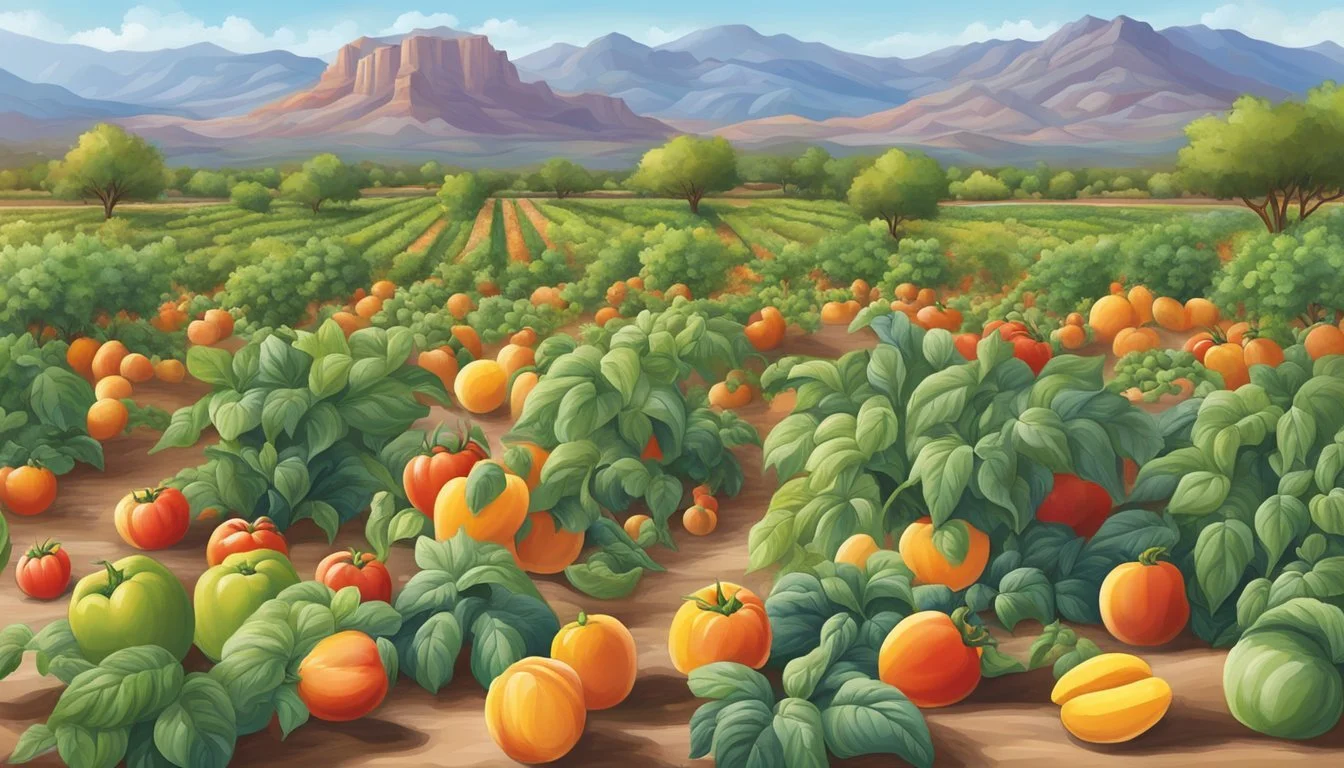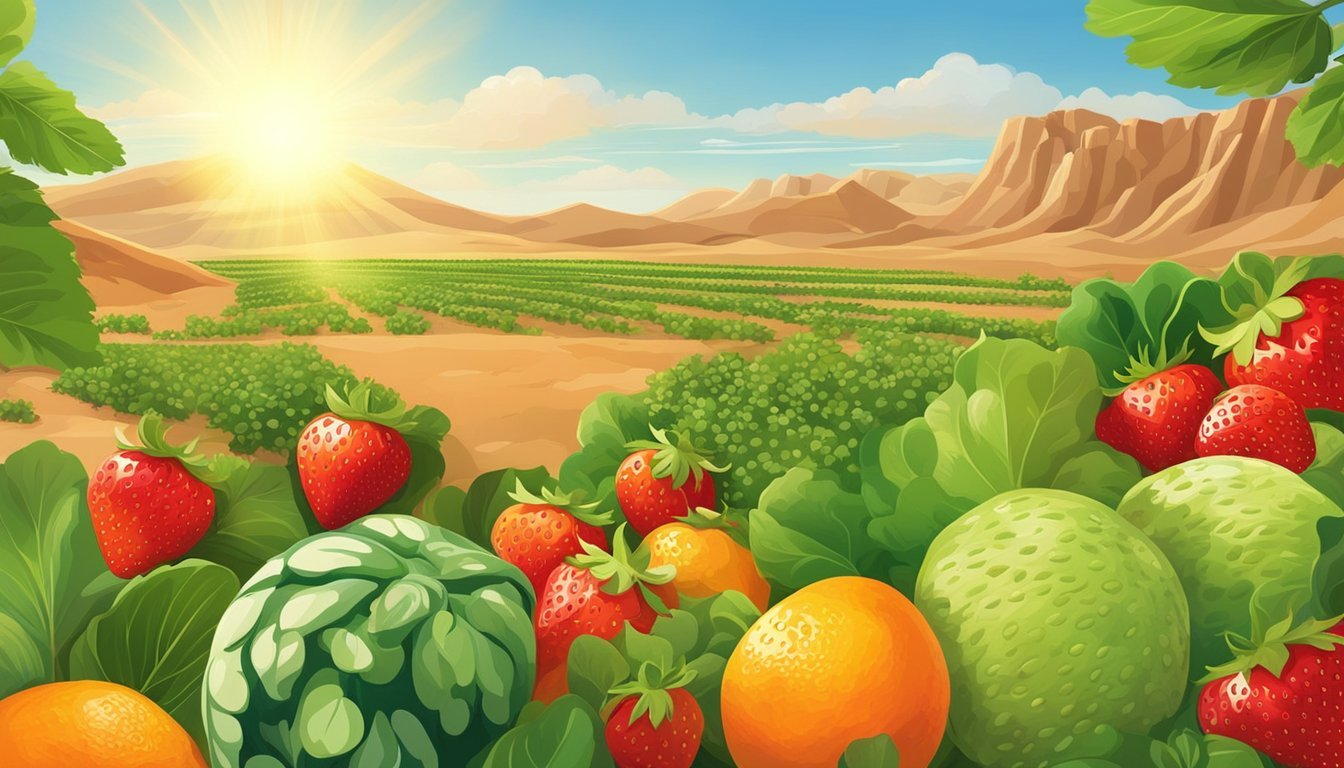Arizona Seasonal Fruit & Vegetables in May
Your Fresh Produce Guide
This Article is Part of our Arizona Seasonal Fruit & Veg Calendar
As the warmth of spring solidifies in Arizona throughout May, the agricultural rhythm of the state syncs with the season. May marks a moment of transition where the lasts of the cool-season crops make their appearance alongside the beginnings of warm-weather favorites. Gardeners and farmers across the state harvest a variety of fruits (What wine goes well with fruits?) and vegetables that thrive in the unique desert climate, supported by the long, sunny days.
Among the bounty, May sees the harvest of stone fruits such as peaches, which start to reach their juicy ripeness. Vegetable patches and fields feature the last of the leafy greens like spinach and lettuces before the heat sets in. Sweet and crunchy carrots (how long do carrots last?) continue to be pulled from the soil, while the citrus season gradually winds down, with the latest oranges and grapefruits being plucked from the trees. This month offers a diverse range of fresh produce for both chefs and home cooks to incorporate into their seasonal recipes.
Farmers' markets and local grocery stores begin to fill with these seasonal offerings, allowing consumers to experience the peak freshness and flavor that comes with produce harvested during its natural growing season. Eating seasonally in Arizona during May not only supports local agriculture but also provides a connection to the regional environment and its seasonal cycles. The abundance of May lays the foundation for the cornucopia of summer produce that is just on the horizon.
Optimal Growing Seasons in Arizona
The success of growing fruits and vegetables in Arizona is heavily influenced by its climate diversity, characterized by a sharp spring to summer transition. Gardeners must adapt to the state's unique environmental conditions to ensure a bountiful harvest.
Understanding Arizona's Unique Climate
Arizona's climate is primarily desert, with hot summers and mild winters. However, there are cooler areas in higher elevations that experience a different growing timeline. Let's explore what this means for growing seasons:
Hot Summers: The intense heat requires crops that can withstand temperatures often soaring above 100°F.
Mild Winters: Winters are favorable for growing a variety of cool-season crops without the need for frost-protection methods in most regions.
Cooler Areas: High altitudes provide a reprieve from the heat, extending the growing season for certain crops that prefer cooler temperatures.
Season Typical Weather Conditions Suitable Crops to Grow Spring Warmer days, risk of late frost Leafy greens, root vegetables Summer Very hot, dry Heat-tolerant varieties like sweet potatoes, okra Winter Mild, occasional frost Citrus fruits, leafy greens
Spring to Summer Transition
Transitioning from spring to summer presents challenges for gardeners in Arizona:
Spring: This season is short, and fluctuating temperatures require monitoring for late frosts that can damage sensitive crops.
Summer Transition: As spring gives way to summer, the focus shifts to planting heat-tolerant varieties that can survive and thrive in desert conditions.
Spring Crops Summer Crops Carrots Melons Beets Sunflowers Broccoli Sweet Potatoes
Planting strategies must accommodate the abrupt change in temperatures, maximizing the use of the spring coolness before the summer heat dominates the growing season. Knowledge of microclimates within Arizona is also crucial, as they impact not only the choice of crops but the timing of planting.
Seasonal Fruits in May
May in Arizona heralds the arrival of a variety of fresh, flavorful fruits, particularly an abundance of citrus and berries, as well as the first wave of stone fruits.
Citrus and Berries Availability
In May, Arizona's citrus fruits are nearing the end of their season, but they can still be found fresh and of high quality. Oranges and grapefruits, well-known for their juicy segments, offer a rich source of vitamin C.
Berry varieties become more prominent in this month. Strawberries can be especially sweet and plentiful. Although blueberries are not as commonly grown in Arizona's climate, imported varieties are often available in markets. Raspberries, while less common, start to appear and deliver their characteristically bright and tart flavors.
Late Spring Stone Fruits
Stone fruits begin to make a seasonal entrance towards the end of May. Their juicy and sweet characteristics are highly anticipated. Apricots are typically among the first to arrive, with their velvety skin and delicate aroma, followed closely by cherries, which range from the sweet, deep red Bing to the more tart Rainier varieties. Peaches, while still early in their season, start to appear with their fuzzy skin and sweet, succulent flesh. They signal the transition towards summer fruit selections.
Seasonal Vegetables in May
In May, Arizona’s warm climate is conducive for a variety of vegetables. Gardens and farms across the state are abundant with fresh produce, including a range of leafy greens and tender root vegetables.
Leafy Greens and Cruciferous Vegetables
Spinach: Thrives in the cool to warm transition, with May being among the last months to harvest before the summer heat.
Lettuce: Various types, such as romaine and leaf lettuce, are in peak season, offering crispness to salads.
Broccoli: A cool-season crop that reaches maturity in May, providing compact, vitamin-rich heads.
Arugula: Known for its peppery flavor, it is generally available until the end of the month.
These vegetables, with their nutritional profiles, are staples in springtime dishes. They're often used in salads, stir-fries, and as accompaniments to grills and roasts.
Root Vegetables and Squashes
Asparagus: Signifies the arrival of spring and persists until early summer, with May being an excellent time for this perennial.
Cucumbers: Start to make their appearance in May, signaling the beginning of summer crop availability.
Root vegetables begin to wind down in May, as temperatures rise. However, some farmers with controlled growing conditions might still offer select varieties. Conversely, summer squashes, such as zucchini, begin to be harvested, marking the transition from spring to summer vegetables.
This selection of vegetables is not exhaustive, with many more types of greens and root crops available, but it offers insight into some of the most common and sought-after options in May.
Harvesting and Storing Tips
Knowing the proper techniques for harvesting and storing fruits and vegetables during Arizona's May harvest can greatly influence their quality and lifespan. This section focuses on the best practices to ensure that produce retains its freshness and flavor from the garden to the table.
Best Practices for Fruit
For fruits, harvesting at the correct stage of ripeness ensures peak flavor and longevity. Here's a brief guide:
Apples: Harvest when the fruit's skin color turns from a greenish to the destined hue respective to its variety and the flavor sweetens. Store apples in a cool, humid place away from strong-smelling foods.
Blackberries: Pick blackberries when they have turned a deep black color and detach easily from the plant. They should be used or frozen within a couple of days, as they are quite delicate.
Citrus Fruits: Oranges, grapefruits, and tangerines should be harvested when they are fully colored and firm. Citrus fruits can be stored in a cool, slightly humid environment for several weeks.
Best Practices for Vegetables
Vegetables require attention to both water and timing to achieve the best harvest.
Beans: They should be picked when they are small and tender before the beans inside start to bulge, and they can be stored in the refrigerator for up to a week.
Cucumbers: Harvest cucumbers when they are medium-sized and firm, and keep them well-irrigated during growing for best results. Store them in the fridge for up to a week.
Summer squash: Pick summer squash when it is between 4 to 6 inches long to ensure a tender and flavorful vegetable. It should be used within a week and kept in a cool place.
For all vegetables, it is important to maintain consistent irrigation during the growing season, ensuring that they receive adequate water to prevent stress, which can adversely affect both yield and quality. After harvest, most vegetables should be stored in a refrigerator to prolong freshness. It’s essential to handle all produce gently to avoid bruising, which can lead to premature spoilage.
Local Food Culture
In May, Arizona's local food scene thrives as farmers markets and CSAs become bustling hubs for seasonal produce. These venues are integral to the state's food culture, offering a diverse array of locally-sourced fruits and vegetables.
Arizona's Farmers Markets
Farmers markets across Arizona, particularly in Phoenix, transform into vibrant meeting spots where the community gathers to purchase a variety of May's seasonal offerings. These markets are known for their:
Freshness: Local produce is picked at the peak of ripeness.
Variety: A wide range of fruits and vegetables is available, including Arizona’s spring favorites like carrots and various leafy greens.
Visitors can interact with growers, gaining insights into where and how their food is cultivated. Phoenix's farmers markets, for example, often provide a festive atmosphere with live music and food stalls, making them a popular weekend destination.
Community Supported Agriculture (CSA)
CSAs in Arizona represent a commitment between local farmers and residents, where consumers pre-purchase a share of the harvest. These programs:
Support Local Farmers: They guarantee income for the farmers, allowing them to plan and sustain their crops.
Offer Seasonal Surprises: Shareholders typically receive a box of assorted seasonal produce, which might include various types of squash and herbs during May.
By participating in a CSA, residents get the dual benefit of enjoying fresh, seasonal food, and fostering community relationships with the farmers who grow it.
Cooking and Recipes
May in Arizona heralds the availability of a wide array of fresh produce, providing an excellent opportunity for home cooks to explore vibrant recipes that make the most of the season’s offerings.
Seasonal Recipes
Utilizing ripe produce can make all the difference in cooking. Seasonal vegetables like carrots, celery (how long does celery last?), and leeks are ideal for creating refreshing spring salads. These ingredients can be combined with fruits such as strawberries and avocados for a flavorful fusion. For those looking to enjoy the heartiness of seasonal vegetables, a dish like roasted Brussels sprouts with a balsamic reduction can make for a delightful side or main course.
Fresh Produce Recipe Ideas Carrots Steamed, glazed, or shredded salads Celery Added to stir-fries and mirepoix Leeks Ideal for creamy leek soups Strawberries Tarts, jams, or fresh in salads Avocados Guacamole or sliced over dishes
Herbs such as cilantro and parsley, also in their prime during May, can elevate dishes with their fresh, zesty flavors.
Preserving the Bounty
Home preserving is a productive way to extend the life of May's produce. Techniques such as canning, pickling, and freezing ensure that the flavors can be savored long past their harvest. For instance, pickled carrots or jalapeños can provide a tangy kick to meals, while pureed strawberries can be frozen to provide a taste of spring in the coming months.
Preservation Method Suitable Produce Canning Fruits like strawberries Pickling Vegetables like carrots and jalapeños Freezing Purees and whole fruits
By incorporating these practices, cooks can continue to enjoy May’s harvest while also minimizing food waste.
Health Benefits of Seasonal Eating
Eating fruits and vegetables that are in season offers several health benefits. The produce harvested at the peak of its natural cycle tends to have a higher nutritional value. Vitamins, minerals, and antioxidants are more abundant in these foods when they are allowed to ripen naturally and consumed soon after harvest.
Nutrient Density
Seasonal produce is typically fresher and, as a result, has a more favorable nutritional profile. For instance:
Vitamins: Essential for immune function and overall health.
Minerals: Important for bone health and metabolic processes.
Antioxidants: Help protect cells from damage.
Optimized Flavor and Freshness
Fruits and vegetables consumed during their natural harvesting season usually offer superior flavor. This enhanced taste can encourage increased consumption of healthy foods, supporting dietary recommendations of 1.5-2 cups of fruits and 2-3 cups of vegetables per day.
Environmental Impact
Choosing seasonal produce supports sustainability. Foods grown in their appropriate season require less human intervention, such as reduced use of pesticides and artificial heating or lighting. They also tend to have a lower carbon footprint due to decreased transportation and storage needs.
Economic Advantages
Consumers benefit economically by purchasing in-season fruits and vegetables, which are often less expensive due to the abundance and reduced transport costs.
In summary, seasonal eating supports not only individual health through increased nutritional intake and flavor satisfaction but also has broader environmental and economic benefits.
Supporting Local Agriculture
Local agriculture in Arizona thrives through the support of community members who prioritize purchasing seasonal fruits and vegetables. During May, the Arizona harvest includes a variety of fresh produce that local farmers offer. Community Supported Agriculture (CSA) programs are a cornerstone in this support system, where individuals can buy shares from local farms and in return, receive boxes of fresh, seasonal produce.
By participating in CSAs, consumers foster a direct relationship with the farmers, ensuring that their money goes straight to the source. This financial support helps sustain farming operations, aids in maintaining the productivity of local land, and promotes the consumption of healthier food options.
The table below highlights typical produce available during May from Arizona’s farms:
Fruits Vegetables Peaches Asparagus Apricots Spinach Cherries Broccoli Strawberries Lettuce
Farmers' markets are another avenue that bolsters Arizona's agriculture. These markets allow farmers to sell produce directly to consumers, who benefit from purchasing fresh and nutritious food grown in their own region. This not only supports farmers economically but also reduces food miles, contributing to lower carbon footprints.
Agricultural festivals and farm tours are additional means through which the public can engage with local farms. They not only serve as educational experiences but also as an opportunity to support farmers by purchasing their goods on-site.
Through these collective efforts, consumers play a pivotal role in sustaining Arizona's agricultural community, ensuring its viability and continued contribution to the state's economy and the health of its residents.









